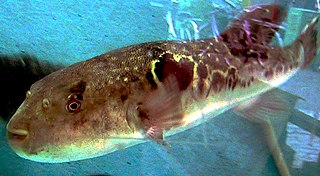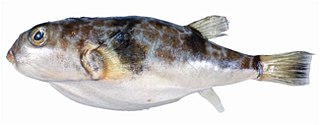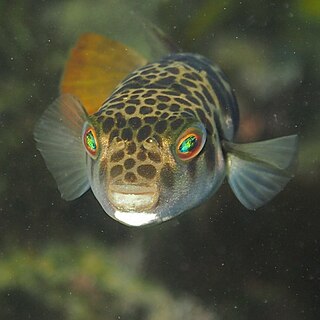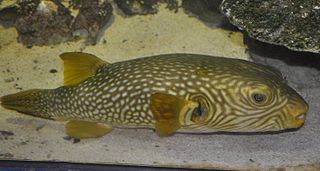
Tetraodontidae is a family of primarily marine and estuarine fish of the order Tetraodontiformes. The family includes many familiar species variously called pufferfish, puffers, balloonfish, blowfish, blowers, blowies, bubblefish, globefish, swellfish, toadfish, toadies, toadle, honey toads, sugar toads, and sea squab. They are morphologically similar to the closely related porcupinefish, which have large external spines. The scientific name refers to the four large teeth, fused into an upper and lower plate, which are used for crushing the hard shells of crustaceans and mollusks, their natural prey.

Tetrodotoxin (TTX) is a potent neurotoxin. Its name derives from Tetraodontiformes, an order that includes pufferfish, porcupinefish, ocean sunfish, and triggerfish; several of these species carry the toxin. Although tetrodotoxin was discovered in these fish and found in several other animals, it is actually produced by certain infecting or symbiotic bacteria like Pseudoalteromonas, Pseudomonas, and Vibrio as well as other species found in animals.

The fugu in Japanese, bogeo or bok (복) in Korean, and hétún in Standard Modern Chinese is a pufferfish, normally of the genus Takifugu, Lagocephalus, or Sphoeroides, or a porcupinefish of the genus Diodon, or a dish prepared from these fish.

Takifugu is a genus of pufferfish, often better known by the Japanese name fugu. There are 25 species belonging to the genus Takifugu and most of these are native to salt and brackish waters of the northwest Pacific, but a few species are found in freshwater of Asia or more widely in the Indo-Pacific region. Their diet consists mostly of algae, molluscs, invertebrates and sometimes crustaceans. The fish defend themselves by inflating their bodies to several times normal size and by poisoning their predators. These defenses allow the fish to actively explore their environment without much fear of being attacked.

Arothron is a genus in the pufferfish family Tetraodontidae found in warm parts of the Atlantic, Indian and Pacific Ocean. These species are sometimes kept in aquaria. The largest species is A. stellatus, which can reach 1.2 m (3.9 ft) in length.

Valentin's sharpnose puffer, also known as the saddled puffer or black saddled toby, is a demersal marine fish belonging to the family Tetraodontidae. The saddled puffer is a small sized fish which grows up to 11 cm. It is widely distributed throughout the tropical and subtropical waters of the Indian Ocean, Red Sea included, and until the oceanic islands of the Pacific Ocean. It inhabits rocky and coral reefs, lagoons and external reef until 55 m. Canthigaster valentini has a diurnal activity.

The blackspotted puffer, also known as the dog-faced puffer, is a tropical marine fish belonging to the family Tetraodontidae.

The masked puffer is a pufferfish in the family Tetraodontidae.

The grass puffer, or Kusa-fugu, is a species of fish in the pufferfish family (Tetraodontidae). This common to abundant species is found in the northwest Pacific Ocean in China, Japan, Korea, the Philippines and Vietnam. It is primarily found in coastal waters, ranging to depths of 20 m (66 ft), but is often seen in brackish water and has also been recorded briefly entering freshwater. The grass puffer reaches up to 15 cm (6 in) in length.

Reicheltia halsteadi, Halstead's toadfish, is a species of pufferfish endemic to Australia. This species grows to a length of 16 centimetres (6.3 in) TL. This species is the only known member of its genus.

Canthigaster rostrata, commonly known as the Caribbean sharp-nose puffer, is a pufferfish from the Western Central Atlantic. The Caribbean sharp-nose puffer is a small fish with a maximum length of 12 cm or approximately 4.7 inches. It can be encountered from the coast of South Carolina to Venezuela, including Bermuda, the Gulf of Mexico, and in the Caribbean Sea. They can live up to 10 years in the wild, females typically live longer due to aggressive male territory behavior. The Caribbean sharp-nose puffer is a highly toxic species of marine fish due to the presence of tetrodotoxin in its tissues and organs. Despite its toxicity, the sharp-nose pufferfish occasionally makes its way into the aquarium trade.

Arothron meleagris, commonly known as the guineafowl puffer or golden puffer, is a pufferfish from the Indo-Pacific, and Eastern Pacific. It is occasionally harvested for the aquarium trade. It reaches 50 cm in length.

Arothron immaculatus, the immaculate puffer or yellow-eyed puffer, is a pale greyish to brownish pufferfish from the Indo-West Pacific. It is a species of marine fish in the family Tetraodontidae.

Arothron stellatus, also known as the stellate puffer, starry puffer, starry pufferfish, or starry toadfish, is a demersal marine fish belonging to the family Tetraodontidae. It is found in shallow water in the Indo-Pacific region.

The smooth toadfish is a species of fish in the pufferfish family Tetraodontidae. It is native to shallow coastal and estuarine waters of southeastern Australia, where it is widespread and abundant. French naturalist Christophe-Paulin de La Poix de Fréminville described the species in 1813, though early records confused it with its close relative, the common toadfish. The two are the only members of the genus Tetractenos after going through several taxonomic changes since discovery.

Arothron caeruleopunctatus, also known as the blue-spotted pufferfish, is a demersal marine fish belonging to the family Tetraodontidae.

Lagocephalus sceleratus, commonly known as the silver-cheeked toadfish, or Sennin-fugu, is an extremely poisonous marine bony fish in the family Tetraodontidae.

Torquigener pleurogramma, commonly known as the weeping toadfish or blowie, is a species of fish in the family Tetraodontidae. It is found in the coastal waters of Australia. Its flesh is highly toxic.

Arothron reticularis, variously known as the reticulated pufferfish, reticulated blowfish or reticulated toadfish, is a ray-finned fish in the family Tetraodontidae. It is native to the tropical and sub-tropical Indo-Pacific region where its habitats include sandy and muddy seabeds, coral reefs, estuaries and mangrove areas.
Arothron multilineatus, the multilined pufferfish, is a species of ray-finned fish in the family Tetraodontidae. It is an uncommon fish and is known only from four specimens from Pagbilao in the Philippines, although photographs of individuals in the Ryukyu Islands, Mozambique and the Red Sea show that it has a wide distribution. It was first described by the Japanese ichthyologist Keiichi Matsuura in 2016.



























